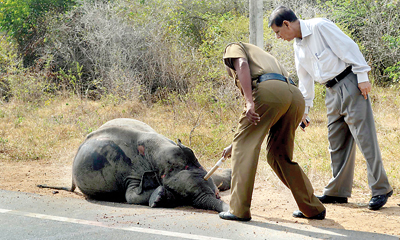A fun nature adventure
Winners of a competition spearheaded by
Dilmah Conservation in cooperation with the Sri Lanka Association for the Advancement of Science (SLAAS), the Field Ornithology Group of Sri Lanka (FOGSL) and the Funday Times were those who participated in Go Wild on the Web and Nature Database making their own environment webpage to celebrate World Environment Day 2012.
Seven lucky winners, six of whom are Funday Times Club members, got the rare opportunity to explore the Sinharaja World Heritage Site, Elephant Transit Home in Udawalawe and Mankada Pottery Centre. The main objective of this event was to encourage children to intermingle with flora and fauna, educate them on its importance and teach them to conserve this precious gift.
Well the best part of the adventure was the guidance by Professor Sarath Kotagama of Colombo University who is a well-known ornithologist (an expert on birds) and an environmentalist, throughout the adventure.We were accompanied by a very friendly and helpful group from Dilmah Conservation and John Larmont, our friendly medic who was there whenever any of us needed aid.
Exploring Sinharaja
The journey began on Saturday August 25, at around 8.00 a.m. All of us were excited and had dreams to see leopards and deer at Sinharaja. It was a special incident for most of us because none of us except Professor Kotagama had ever
visited Sinharaja forest before.
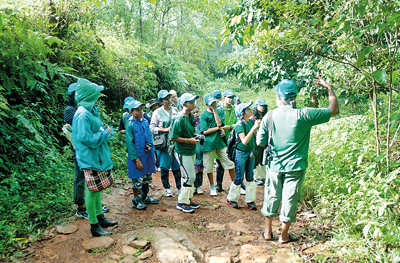 Sinharaja |
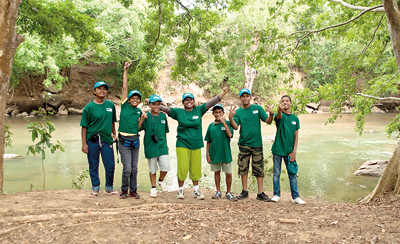 Participants from Left to Right: Janani Sachethana, Wasana Siriwardena, Savindu Herat, Devindi Gunarathne, Chaveendra Dunuwille, Naheed Roomy and Adhil Nawushad. |
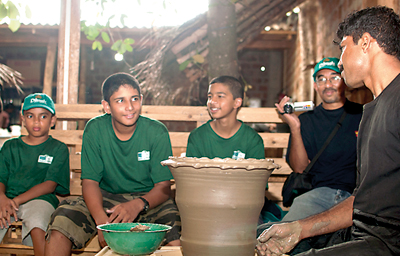 Mankada Pottery Centre |
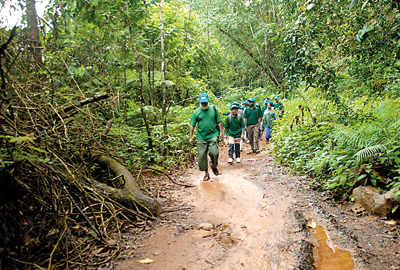 Sinharaja |
Did you know that Sinharaja is the only natural heritage site in Sri Lanka? And it was declared a UNESCO World Heritage Site and a Man and Biodiversity Reserve too. Now aren’t we proud of that?
Our arrival was welcomed by heavy rain that added beauty to the rainforest and we had to fight back the chilling rain with our umbrellas and raincoats. The professor said that there wouldn’t be any fun in a rainforest if it did not rain. After lunch at Matins Place we went into the forest with booklets to refer to when we saw a new plant or bird. He also told us that we had to be very silent in the forest to hear the music of it.
Amidst the frequent leech attacks we saw different trees and creepers.“Many rainforest trees turn a red colour when they flush,” professor said, adding that the reason for this was because the leaves reflect the colour they do not absorb so they turn red because they do not absorb heat. He also said that the tender leaves are waxy to protect themselves from the sun which will damage them if they get overly exposed. We couldn’t see many because it was late and raining.
After walking a few metres into the forest we returned to our lounging place. In the night professor gave us a lecture about the importance of the Sinharaja forest.
However the next morning was welcomed with sweet singing of the birds.We were able to see some endemic birds, insects and plants. It was amazing to listen to different chirps of birds as they called each other when they found food or were in danger. We also saw the giant tree in Sinharaja which was a Nawada tree and 43 metres tall!
On to Uda Walawe
Later that day we packed to go to Udawalawe which is in the dry zone. On the third day we started off early on a safari to the Udawalawe National Park where we saw dozens of elephants, peacocks, monkeys and deer.
Did you know that Udawalawe has fewer trees because the elephants prefer to live in open areas? We also learnt that the spiny mouse found in this area is endemic to Sri Lanka and the Modara plants grow only in Udawalawe area.
The elephants we have now in Sri Lanka are called Elephus Maximus identified in 1936.
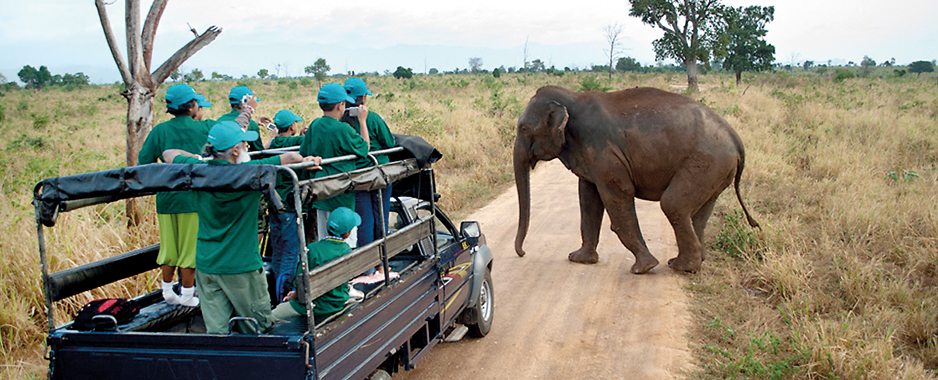
Elephant at Udawalawe
These animals can hear more sound than a human being and also the elephant brain grows throughout its lifetime.Professor explained that we haven’t yet identified as to at which age the elephants die. “Elephants teeth continue to grow till it’s 40 years. Because it always consumes food and grinds all the time these teeth start to wear out. So now we have discovered that the elephants die after these teeth are worn out and it cannot consume any food,” he said.
After the venture into the Udawalawe Park we went to the Elephant Transit Home at Udawalawe. We learnt that there were 38 – 40 baby elephants fed at the ETH. They were fed around 5 – 6 litres of milk per baby elephant thrice a day. It was a fun experience for all of us to see these little ones come running to drink the milk. Also we learnt that the Dilmah Conservation in collaboration with Wildlife Conservation Department is managing the place.
Our last stop was the Mankada Pottery Centre. This centre was built to help the potter community living in and around Udawalawe. People of that area have been potters and created different types of pottery for a living but when new technology came in these artists started to go away. Dilmah Conservation has set up this place where the potters from the area could create potteryware inspired by nature. The kids were also taught to make their own clay elephants and make different types of potterywork on a wheel which all of us enjoyed.
Here’s what some kids had to say to the Funday Times. “I had a time I never had in my life before. It was adventurous and I enjoyed listening to birds and trying to understand what they said,” said Devindi Gunarathne from Ratmalana.
Naheed Roomy from Negombo said that with the information he gathered from professor he is going to update his website and tell all his friends about how important it is to conserve nature.
All in all it was a very informative trip where we learnt a lot and all of us enjoyed every bit of it.
Follow @timesonlinelk
comments powered by Disqus
























